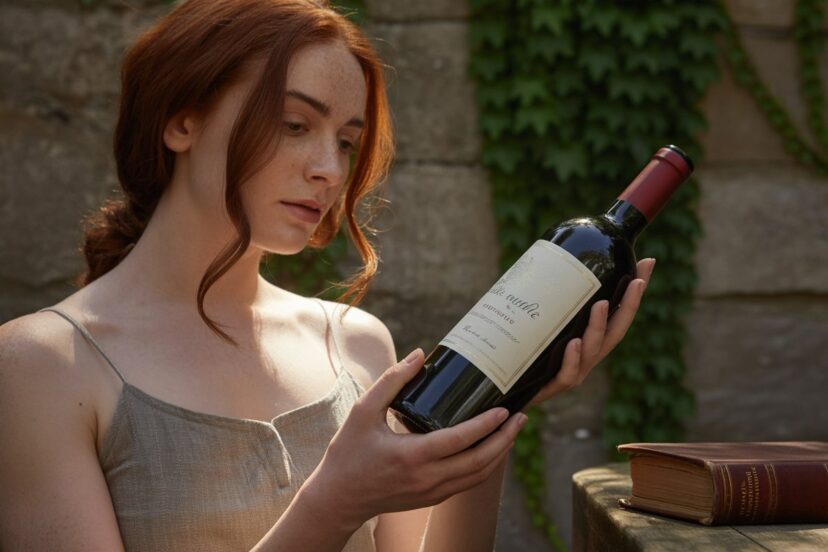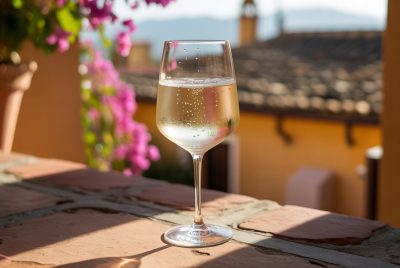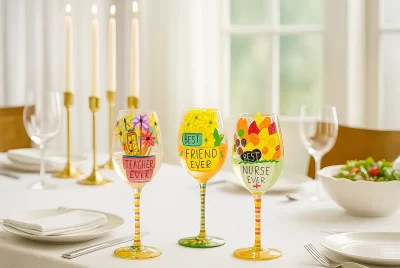Understanding Wine Labels: What All Those Terms Really Mean
Post Disclaimer
*We may earn a commission for purchases made using our links. Please see our disclosure to learn more.
Standing in a wine shop, surrounded by hundreds of bottles adorned with elegant labels filled with mysterious terms, can feel overwhelming. Those cryptic words and phrases that seem designed to intimidate rather than inform often leave wine enthusiasts feeling frustrated and uncertain about their selections.
The world of wine labels doesn’t have to remain a mystery. Behind every confusing term lies valuable information that can transform your wine-buying experience from guesswork into informed decision-making. Understanding these labels opens doors to discovering wines that perfectly match your preferences and occasions.
Wine labels serve as the primary communication between winemaker and consumer, yet they often feel like they’re written in a foreign language. This confusion stems from centuries of winemaking traditions, regional regulations, and marketing approaches that have created a complex tapestry of terminology. Learning to decode wine labels represents more than just understanding vocabulary—it’s about gaining confidence in wine selection and developing a deeper appreciation for the craft behind each bottle.
“Wine is one of the most civilized things in the world and one of the most natural things of the world that has been brought to the greatest perfection, and it offers a greater range for enjoyment and appreciation than, possibly, any other purely sensory thing.”
— Ernest Hemingway
Key Takeaways
• Understanding wine labels transforms wine purchasing from intimidating guesswork into informed decision-making
• Geographic appellations provide quality and style indicators that help predict wine character before opening
• Production method terms reveal complexity clues, including oak treatment, fermentation techniques, and aging processes
• European classification systems offer quality hierarchies worth learning, despite their initial complexity
• New World wines emphasize varietal and regional characteristics through simpler labeling approaches
• Technical specifications like alcohol content, residual sugar, and production methods provide valuable insights into wine style
• The ability to distinguish between meaningful information and marketing language prevents confusion and disappointment
• Building wine label literacy requires patience and practice, but pays dividends in improved wine selections
• Wine labels serve as bridges between winemakers and consumers, sharing stories of place, tradition, and technique
• Understanding these communications enriches the entire wine experience and builds confidence in personal preferences
The Foundation of Wine Label Understanding
Geographic Origins and Appellations
The geographic origin of wine appears prominently on most labels, representing far more than simple location identification. Appellations constitute officially designated wine regions with specific regulations governing grape varieties, production methods, and quality standards. These designations guarantee that wines meet particular criteria related to grape selection, yields, and production techniques.
French wines display terms like “Appellation d’Origine Contrôlée” (AOC), indicating strict adherence to regional standards developed over centuries. Each AOC region maintains unique rules about permitted grape varieties, maximum yields per hectare, minimum alcohol levels, and approved winemaking practices. Understanding these regulations helps predict wine styles and quality levels before opening the bottle.
Italian labels feature “Denominazione di Origine Controllata” (DOC) or the higher classification “Denominazione di Origine Controllata e Garantita” (DOCG). These systems ensure wines reflect their regional character while maintaining consistent quality standards. DOCG wines undergo additional government testing and approval processes, representing Italy’s highest quality tier.
American wines utilize the American Viticultural Area (AVA) system, which focuses primarily on geographic boundaries rather than production methods. AVAs define wine regions based on climate, soil, and topography, allowing winemakers more flexibility in grape selection and production techniques compared to European systems.
Spanish wines employ the “Denominación de Origen” (DO) system, with premium “Denominación de Origen Calificada” (DOCa) status reserved for exceptional regions like Rioja and Priorat. These classifications combine geographic boundaries with aging requirements and quality standards.
Vintage Significance and Non-Vintage Wines
The vintage refers to the year grapes were harvested, and this information significantly impacts wine character and value. Weather conditions vary dramatically from year to year, affecting grape ripeness, acidity levels, sugar concentration, and overall wine quality. Understanding vintage variations helps consumers select wines at optimal drinking windows.
Exceptional vintages often command premium prices due to ideal growing conditions that produce concentrated, well-balanced wines with extended aging potential. Conversely, challenging vintages might offer excellent value when winemakers successfully navigate difficult conditions to create appealing wines at lower price points.
Some wines, particularly Champagnes and certain blends, carry “Non-Vintage” (NV) designations. These wines combine grapes from multiple harvest years to achieve consistent flavor profiles representing the producer’s house style. Non-vintage wines aren’t inferior to vintage wines; they demonstrate the winemaker’s skill in maintaining quality across varying annual conditions.
Climate change increasingly affects vintage consistency, making knowledge of regional weather patterns valuable for wine selection. Cool, wet years might favor white wine production, while warm, dry conditions often benefit red wine development.
Technical Specifications and Production Methods
Alcohol Content and Chemical Composition
Alcohol by volume (ABV) percentages provide immediate insights into wine style, body, and intensity. Lighter wines typically range from 11-13% ABV, indicating cooler growing conditions or early harvest timing that preserves natural acidity. Medium-bodied wines usually fall between 13-14% ABV, representing balanced ripeness and moderate climate conditions.
Full-bodied wines often reach 14-16% ABV, suggesting riper grapes from warmer climates or extended hang time. Higher alcohol levels contribute to wine body and mouthfeel while potentially masking subtle flavors if not properly balanced with acidity and tannins.
Residual sugar measurements appear on some labels, particularly for dessert wines and off-dry styles. This specification indicates sweetness levels measured in grams per liter. Bone-dry wines contain less than 4 grams per liter, while sweet wines exceed 45 grams per liter. Understanding residual sugar helps predict wine style and food pairing compatibility.
Sulfite declarations appear mandatory in many countries, addressing potential allergic reactions rather than indicating wine quality. Sulfites occur naturally during fermentation and are often added to prevent oxidation and bacterial spoilage. The phrase “Contains Sulfites” provides necessary allergy information without reflecting production quality or methods.
pH levels occasionally appear on technical wine labels, indicating acidity and aging potential. Lower pH wines (higher acidity) typically age longer and pair better with food, while higher pH wines might taste softer but have limited aging potential.
Oak Treatment and Aging Descriptors
Oak treatment dramatically influences wine character, and labels often provide crucial information about these processes. Barrel fermented wines develop different textures and flavors compared to those fermented in stainless steel tanks. Oak barrels contribute vanilla, spice, and toasty flavors while allowing controlled oxidation that softens tannins and enhances complexity.
French oak versus American oak designations indicate different flavor profiles. French oak typically imparts subtle vanilla and spice notes with tighter grain structure, while American oak contributes more pronounced vanilla and coconut flavors with looser grain allowing greater oxygen exchange.
Terms like sur lie indicate wines remained in contact with dead yeast cells after fermentation, creating creamy textures and enhanced complexity through autolysis processes. This technique particularly benefits white wine production, adding richness without oak influence.
Malolactic fermentation converts sharp malic acid into softer lactic acid, creating rounder, creamier wines with buttery characteristics. While primarily a technical process, some labels highlight this technique as a quality and style indicator, particularly for Chardonnay and red wine production.
Estate bottled indicates grapes were grown and wine was produced at the same location, suggesting greater quality control throughout the process. Estate bottling allows winemakers complete oversight from vineyard to bottle, often resulting in more consistent and distinctive wines.
Regional Classification Systems Deep Dive
European Quality Hierarchies
European wine regions employ sophisticated hierarchical classification systems indicating quality levels and production standards. These systems evolved over centuries to protect regional wine reputations while establishing consumer confidence in authenticity and quality.
French classifications begin with basic Vin de France, allowing grape blending from anywhere within the country with minimal restrictions. Indication Géographique Protégée (IGP) wines demonstrate regional character with moderate restrictions on grape varieties and production methods, offering excellent value while maintaining geographic identity.
The prestigious Appellation d’Origine Contrôlée (AOC) system represents France’s highest quality tier, with strict regulations governing every aspect of production. AOC wines must use approved grape varieties, respect maximum yields, achieve minimum alcohol levels, and pass official tasting panels. These requirements ensure wines authentically represent their terroir and regional traditions.
German wine labels feature Prädikatswein classifications based entirely on grape ripeness at harvest, measured by must weight (sugar content). Kabinett wines use the least ripe grapes, producing light, delicate wines with lower alcohol. Spätlese (late harvest) wines show increased ripeness and intensity, while Auslese wines use very ripe, hand-selected grapes creating concentrated, often sweet wines.
Beerenauslese and Trockenbeerenauslese represent Germany’s sweetest wine categories, using botrytis-affected grapes that concentrate sugars and flavors through dehydration. These rare wines command premium prices due to labor-intensive production and exceptional aging potential.
Italian classifications include basic Vino da Tavola at entry level, Indicazione Geografica Tipica (IGT) for regional wines with moderate restrictions, and Denominazione di Origine Controllata (DOC) for quality wines meeting strict regional standards. The highest tier, Denominazione di Origine Controllata e Garantita (DOCG), includes government testing and approval, guaranteeing authenticity and quality.
New World Labeling Philosophies
New World wine regions generally employ simpler labeling systems emphasizing grape varieties and geographic origins over complex regulations. These straightforward approaches make wine selection more accessible while highlighting winemaker creativity and innovation.
Australian wines feature Geographical Indications (GI) designating wine regions without European-style production restrictions. This system allows winemakers flexibility in grape selection and techniques while maintaining geographic authenticity. Australian labels often emphasize varietal character and regional climate influences.
American wines prioritize varietal labeling, requiring minimum 75% of named grape varieties in blends. This approach helps consumers understand wine styles while allowing winemaking innovation. American Viticultural Areas (AVAs) provide geographic context without restricting grape varieties or production methods.
South African wines combine geographic designations with quality classifications, including Wine of Origin (WO) status guaranteeing geographic authenticity. Chilean wines emphasize varietal character and regional distinctions, often highlighting specific valley appellations with unique climate characteristics.
New Zealand wines focus on regional distinctions and sustainable production practices, often highlighting organic or biodynamic certifications alongside geographic origins. These labels emphasize environmental stewardship and terroir expression through minimal intervention winemaking.
Decoding Marketing Language vs. Technical Terms
Meaningful Production Indicators
Reserve wines traditionally represented producers’ finest offerings with extended aging and superior grape selection. However, this term lacks legal definition in many regions, making producer research essential for understanding specific reserve criteria. Established producers typically maintain consistent reserve standards, while newer operations might use the term more liberally.
Old vine or “Vieilles Vignes” designations refer to grapes from mature vines, typically over 30-50 years old. These vines produce smaller yields but often concentrate flavors, resulting in more complex wines with enhanced depth and character. Old vine wines frequently justify premium pricing through superior fruit quality.
Single vineyard wines showcase specific site characteristics, highlighting terroir expression and vineyard management practices. These designations often indicate premium quality and distinctive character reflecting unique soil, climate, and topographic conditions.
Hand harvested or “Handpicked” indicates careful grape selection and gentle handling, though machine harvesting can produce excellent results when properly executed. This designation often accompanies premium wines where selective harvesting improves grape quality.
Sustainable and Organic Certifications
Organic wine certifications require verification by authorized organizations, ensuring vineyard management without synthetic pesticides, herbicides, or fertilizers. Organic winemaking also restricts certain additives and processing aids, though regulations vary between countries and certifying bodies.
Biodynamic practices represent holistic farming approaches treating vineyards as complete ecosystems. Biodynamic certification requires organic compliance plus additional practices like lunar cycle timing and specific preparations. These methods often produce distinctive wines reflecting unique terroir characteristics.
Sustainable certifications encompass environmental, social, and economic considerations, including water conservation, energy efficiency, and fair labor practices. Sustainable programs vary significantly between regions and organizations, making specific certification research valuable.
Carbon neutral or Carbon negative claims indicate environmental commitments beyond traditional certifications, often involving renewable energy, carbon sequestration, and emissions reduction programs. These designations reflect increasing industry focus on climate change mitigation.
Building Wine Selection Confidence
Matching Labels to Personal Preferences
Understanding wine label terminology enables better alignment between personal tastes and bottle selections. Readers preferring crisp, refreshing wines should seek terms indicating stainless steel fermentation, sur lie aging, high acidity, or cool climate origins. These descriptors suggest bright, food-friendly wines with mineral characteristics.
Those enjoying rich, full-bodied wines might prioritize labels mentioning oak aging, malolactic fermentation, concentrated flavors from old vines, or warm climate origins. These indicators suggest powerful wines with complexity and aging potential.
Climate descriptors provide valuable preference guidance. Cool climate wines tend toward elegance, restraint, and food compatibility, while warm climate wines often deliver power, richness, and immediate appeal. Mediterranean climates typically produce balanced wines combining freshness with ripeness.
Elevation indicators help predict wine style, as high-altitude vineyards often produce wines with intense flavors and natural acidity due to dramatic temperature variations and intense sunlight exposure.
Value Recognition Through Label Literacy
Wine label knowledge helps establish realistic quality and price expectations, preventing overpayment for basic wines marketed with impressive but meaningless terminology. Understanding classification systems reveals when premium pricing reflects genuine quality versus marketing positioning.
Lesser-known appellations often provide exceptional value when label literacy reveals quality indicators justifying higher prices. Emerging regions with favorable climate and skilled winemaking frequently offer alternatives to established, expensive appellations.
Producer reputation significantly affects pricing, but individual quality varies considerably within any appellation. Learning to identify quality indicators beyond geographic origin leads to value discoveries and prevents disappointment from prestigious but mediocre wines.
Négociant versus Estate distinctions affect pricing and style consistency. Négociant wines blend grapes from multiple sources, often providing good value and consistent style, while estate wines showcase single-property character at potentially higher prices.
Practical Shopping Strategies
Systematic Label Analysis
Effective wine shopping begins with identifying desired styles based on occasion, food pairing requirements, or personal preferences. Use appellation knowledge to narrow selections within preferred price ranges, comparing similar wines through production method indicators and technical specifications.
Create mental categories for different wine needs: everyday drinking, special occasions, food pairing, and cellar aging. Each category benefits from different label priorities, with everyday wines emphasizing value and consistency while special occasion wines might justify premium appellations and extended aging.
Document successful purchases with label photographs and personal ratings, creating visual references for future shopping. Include notes about serving occasions, food pairings, and specific enjoyment factors to build comprehensive selection criteria.
Vintage research becomes valuable for premium wine purchases, as price variations between good and exceptional years can be substantial. Online vintage charts and regional weather reports provide historical context for informed buying decisions.

Retailer Relationships and Expert Guidance
Knowledgeable wine retailers appreciate informed questions about specific label terms and producer reputations. Building relationships with trusted wine shops provides access to expert guidance, advance notice of special arrivals, and customized recommendations based on established preferences.
Wine club memberships often provide access to limited production wines with detailed technical information and producer stories. These programs frequently include educational materials explaining label terminology and production methods.
Restaurant wine lists offer opportunities to explore unfamiliar labels with sommelier guidance. Professional recommendations help navigate complex wine lists while building knowledge about different regions and producers.
Wine events and tastings provide hands-on education about label terminology, allowing direct comparison between different styles, regions, and production methods while building relationships with industry professionals.
Advanced Label Reading Techniques
Identifying Emerging Trends and Opportunities
Modern wine labels increasingly emphasize sustainability credentials, climate change adaptation, and innovative winemaking techniques. Understanding these evolving trends helps identify forward-thinking producers and emerging value opportunities.
Natural wine designations indicate minimal intervention winemaking with reduced sulfite additions and spontaneous fermentation. These wines often display unique character but require understanding of potential style variations and stability considerations.
Minimal intervention or Low intervention winemaking emphasizes vineyard expression over technological manipulation. These approaches often produce distinctive wines reflecting terroir characteristics and vintage variations.
Indigenous yeast fermentation uses naturally occurring vineyard yeasts rather than commercial cultures, potentially creating more complex and distinctive flavor profiles. This technique requires careful management but often rewards with unique wine character.
Understanding Collector and Investment Indicators
Certain label elements indicate wines with aging potential and collector interest. Vintage Port declarations occur only in exceptional years, making these wines valuable for cellaring and investment purposes. Understanding Port house vintage patterns helps identify genuine opportunities.
Grand Cru and Premier Cru designations in Burgundy and Champagne indicate vineyard classification quality, with Grand Cru representing the highest tier. These classifications significantly affect pricing and aging potential.
Single malt influence in wine includes single varietal, single vineyard, and single vintage expressions that highlight specific characteristics and craftsmanship. These wines often demonstrate superior aging potential and distinctive character.
Limited edition and Library release wines from established producers represent opportunities to access mature wines with proper provenance and storage history.
Frequently Asked Questions
Q: Does a higher price always indicate better wine quality?
A: Not necessarily. Price reflects many factors including region prestige, production costs, marketing expenses, and scarcity. Understanding appellations, production methods, and vintage conditions helps identify genuine quality and value across all price ranges, often revealing exceptional wines from lesser-known regions at moderate prices.
Q: What’s the difference between “Reserve” and regular wines?
A: “Reserve” traditionally indicates a producer’s premium offering with extended aging, superior grape selection, or special production methods. However, the term lacks legal definition in many regions, making producer research essential. Established wineries typically maintain consistent reserve standards, while newer operations might use the term more liberally for marketing purposes.
Q: How important is vintage year for wine selection?
A: Vintage significance varies dramatically by region, wine style, and climate stability. Regions with consistent weather patterns show minimal year-to-year variation, while areas with variable climates can produce dramatically different wines annually. Understanding specific regional vintage patterns and consulting vintage charts helps make informed selections, particularly for premium wines intended for aging.
Q: Are organic or biodynamic wines automatically better than conventional wines?
A: Organic and biodynamic certifications indicate farming and production practices rather than wine quality directly. Many exceptional wines use these methods, focusing on terroir expression and environmental stewardship. However, quality ultimately depends on winemaking skill, grape quality, and vintage conditions regardless of certification status.
Q: Should I be concerned about sulfites in wine?
A: Sulfites occur naturally during fermentation and are commonly added as preservatives to prevent oxidation and spoilage. They’re generally harmless unless you have specific sulfite allergies, which affect less than 1% of the population. The “Contains Sulfites” label primarily provides allergy awareness rather than quality indication, as virtually all wines contain some sulfites naturally.




